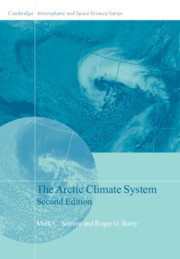Book contents
- Frontmatter
- Dedication
- Contents
- Preface
- Acknowledgments
- List of Acronyms
- List of Selected Web Sites
- 1 The Evolution of Knowledge about the Arctic and Its Climate
- 2 Physical Characteristics and Basic Climatic Features
- 3 The Basic Atmospheric and Ocean Energy Budgets
- 4 The Atmospheric Circulation
- 5 Energy Exchanges at the Surface
- 6 Precipitation, Net Precipitation, and River Discharge
- 7 Arctic Ocean–Sea Ice–Climate Interactions
- 8 Climate Regimes of the Arctic
- 9 Modeling the Arctic Climate System
- 10 Arctic Paleoclimates
- 11 The Uncertain Future
- References
- Index
- Plate Section
7 - Arctic Ocean–Sea Ice–Climate Interactions
Published online by Cambridge University Press: 05 August 2014
- Frontmatter
- Dedication
- Contents
- Preface
- Acknowledgments
- List of Acronyms
- List of Selected Web Sites
- 1 The Evolution of Knowledge about the Arctic and Its Climate
- 2 Physical Characteristics and Basic Climatic Features
- 3 The Basic Atmospheric and Ocean Energy Budgets
- 4 The Atmospheric Circulation
- 5 Energy Exchanges at the Surface
- 6 Precipitation, Net Precipitation, and River Discharge
- 7 Arctic Ocean–Sea Ice–Climate Interactions
- 8 Climate Regimes of the Arctic
- 9 Modeling the Arctic Climate System
- 10 Arctic Paleoclimates
- 11 The Uncertain Future
- References
- Index
- Plate Section
Summary
Overview
The mean seasonal variation of sea ice extent was reviewed in Chapter 2 along with some basic aspects of sea ice circulation, morphology, and the factors contributing to sea ice growth. As introduced there, the existence of the ice cover is not simply a function of low winter temperatures; its formation and persistence is fostered by the existence of a relatively fresh surface layer, maintained by river runoff, the import of low-salinity water through the Bering Strait, net precipitation over the Arctic Ocean, and the distillation process associated with ice formation itself. Seasonally, summer melt of the fairly fresh ice is also important. The characteristics of river runoff were examined in Chapter 6. In Chapter 3, we discussed the role that sea ice plays in the Arctic’s atmospheric energy budget, with sea ice melt maintaining a downward net surface flux (from the atmosphere to the ocean) in summer, and sea ice growth adding heat to the atmosphere in winter. Chapter 5 shed further light on this issue through a review of surface energy exchanges. In Chapter 4, we documented sea ice impacts on regional aspects of the atmospheric circulation through enhanced baroclinicity along the ice margins, and how the atmospheric circulation may now be responding to observed reductions in ice extent. The present chapter extends our understanding of sea ice and its interactions with the atmosphere and ocean.
The growth of sea ice up to about 1 m in thickness can be approximated in terms of freezing degree days. This is because the temperature gradient in thin ice is essentially linear. By contrast, the growth of thicker ice, primarily multiyear ice, which has historically attained equilibrium thicknesses of 3.5–4.5 m while surviving ten years or more, is complicated by thermal history, seen as nonlinear vertical temperature gradients. Ice melts at both its top and bottom surfaces, with the process again less straightforward for thick ice. For example, in October when thin ice is growing quickly in leads, thick ice may still be decreasing in thickness owing to bottom melt, the reason being that the autumn cooling has not yet affected the lowest part of the ice. Over the past several decades, the Arctic has lost much of its thickest and oldest multiyear ice.
- Type
- Chapter
- Information
- The Arctic Climate System , pp. 209 - 248Publisher: Cambridge University PressPrint publication year: 2014



